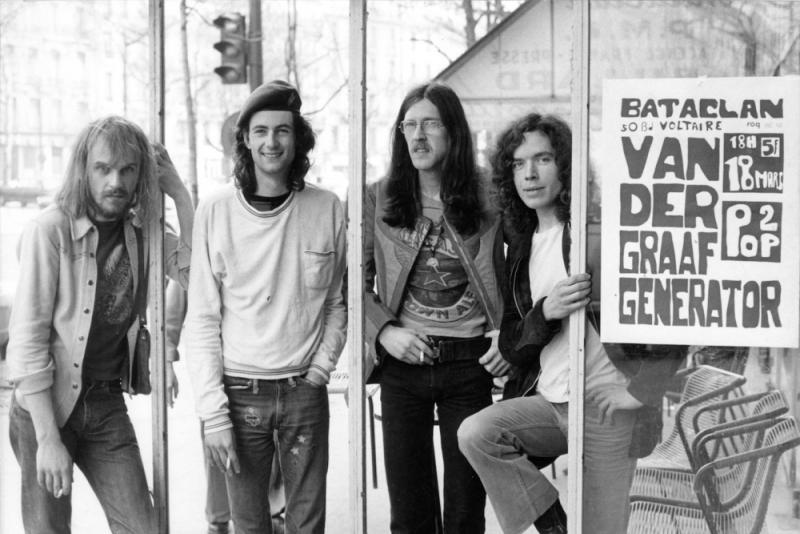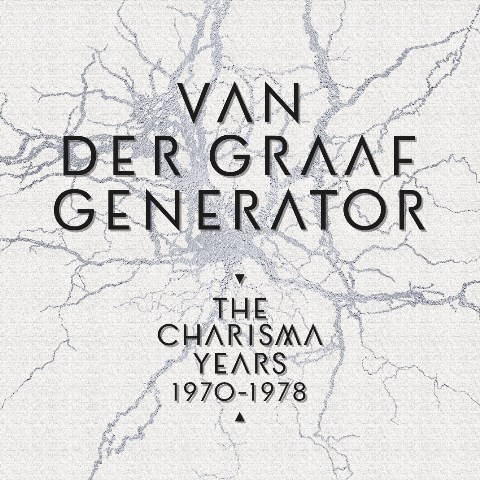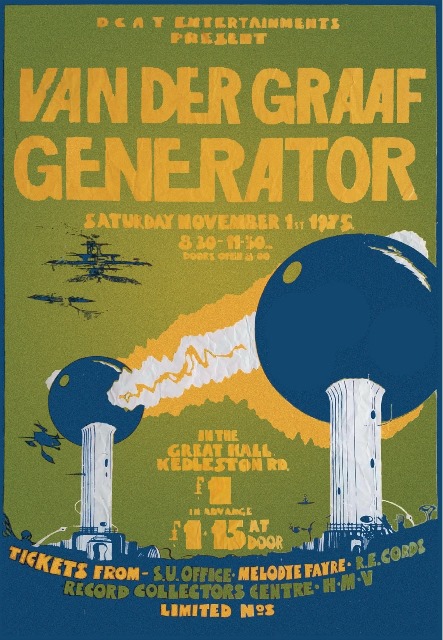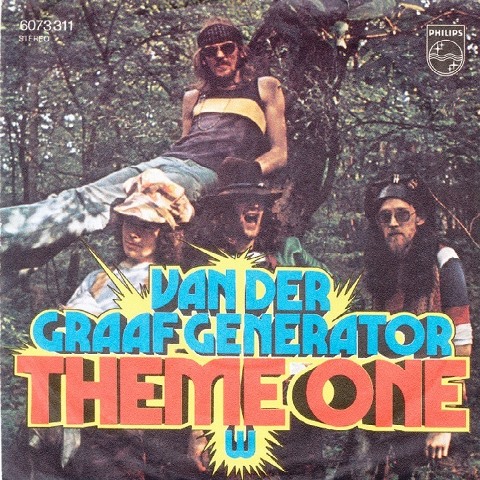Reissue CDs Weekly: Van der Graaf Generator - The Charisma Years 1970-1978 | reviews, news & interviews
Reissue CDs Weekly: Van der Graaf Generator - The Charisma Years 1970-1978
Reissue CDs Weekly: Van der Graaf Generator - The Charisma Years 1970-1978
Statement-piece box set honouring a band like no other

“There should be some kind of spirit there which is outside whoever is in the band. The spirit of the band, wanting still to play songs, real songs, wanting to play complicated music to a certain extent. Fairly dense arrangements, also difficult pieces of music, not to be difficult but just because that’s a challenge. To do all that and then also play with a degree of anarchy, chaos, and fire and spirit. That’s the spirit of Van der Graaf.”
So said a drawn-looking, jumpy Peter Hammill on 17 June 1978. He’s on Austrian TV, sitting on an unmade bed in a hotel room, with a cigarette in his hand – a packet of Camels sits on the adjacent window ledge. It’s no glamour-laden tableau, and he’s talking about a band which would split during the next month. The concert footage accompanying the interview caught their last show. Seemingly unsuspecting of what was coming, Hammill nailed the band’s mission statement as he was talking. Van der Graaf Generator were trading as Van der Graaf at that point. Their then-current line-up was unusual: Hammill plus Charles Dickie (cello), Guy Evans (drums), Nic Potter (bass) and Graham Smith (violin).
 Track back to 23 March 1972 and Van der Graaf Generator are playing for Belgian TV. The band are Hammill plus Hugh Banton (keyboards, vocals), Evans (drums) and David Jackson (saxophone – sometimes playing two at time, a la Roland Kirk). Unusual, but less so than in 1978. This line-up crashed-out in August 1972. Belgium’s television viewers were confronted with a 24-minute, live-in-the-studio version of “A Plague of Lighthouse Keepers”. From their October 1971 album Pawn Hearts, it was the first time the composition had been played live. Hammill was guided by the album’s lyric sheet, propped-up on his electric piano’s music stand. “A Plague of Lighthouse Keepers” occupied the whole of side two of the album.
Track back to 23 March 1972 and Van der Graaf Generator are playing for Belgian TV. The band are Hammill plus Hugh Banton (keyboards, vocals), Evans (drums) and David Jackson (saxophone – sometimes playing two at time, a la Roland Kirk). Unusual, but less so than in 1978. This line-up crashed-out in August 1972. Belgium’s television viewers were confronted with a 24-minute, live-in-the-studio version of “A Plague of Lighthouse Keepers”. From their October 1971 album Pawn Hearts, it was the first time the composition had been played live. Hammill was guided by the album’s lyric sheet, propped-up on his electric piano’s music stand. “A Plague of Lighthouse Keepers” occupied the whole of side two of the album.
This TV appearance, on show called Pop Shop, is for-real remarkable. On record, “A Plague of Lighthouse Keepers” is a challenging portmanteau piece. Live, it’s incredible the band could perform the whole of what had been recorded in sections and subsequently stitched-together. Moreover, it’s bizarre watching the recital of one of the most peculiar, most complex pieces of music which emerged from the British prog-rock scene. The playing is unflashy, but complex – as is the interplay between the band members. If King Crimson was for those who found Genesis too straightforward, Van der Graaf Generator was for anyone unfulfilled by King Crimson. Van der Graaf Generator may have been more abrasive on other occasions, but on Pop Shop there was still nothing reined in. Aggression is innate.
 Both television appearances are collected on a Blu-ray disc which is part of the very smart The Charisma Years 1970-1978, a 17 CD, three Blu-ray disc box set. The final disc – with the TV appearances – is titled The Video Vaults and it’s a fair bet most owners will head there first. The package includes all the albums the band recorded for Charisma: The Least We Can Do is Wave to Each Other (1970), H to He Who Am the Only One (1970), Pawn Hearts (1971), Godbluff (1975), Still Life (1976), World Record (1976), The Quiet and The Quiet Zone / The Pleasure Dome (1977) and Vital (1978). Bonuses brought together include non-album tracks from singles, BBC session recordings and a CD of tracks surplus to Pawn Hearts (it was initially envisioned as a double album and these tracks were first issued in 2005). A previously issued live show from Rimini in 1975 is also included, as is a hitherto unreleased show from Paris’s La Maison de la Mutualité (6 December 1976). CDs 14, 15, 16 and 17 assemble new mixes of H to he Who Am the Only One, Pawn Hearts, Godbluff and Still Life. The two non-video Blu-rays collect these in hi-res audio along with the original mixes and surround-sound mixes. It’s all in an album-size slipcase with a hardback book and a separate fold-out with images of the original album master tapes. The discs come in two fold-over wallets.
Both television appearances are collected on a Blu-ray disc which is part of the very smart The Charisma Years 1970-1978, a 17 CD, three Blu-ray disc box set. The final disc – with the TV appearances – is titled The Video Vaults and it’s a fair bet most owners will head there first. The package includes all the albums the band recorded for Charisma: The Least We Can Do is Wave to Each Other (1970), H to He Who Am the Only One (1970), Pawn Hearts (1971), Godbluff (1975), Still Life (1976), World Record (1976), The Quiet and The Quiet Zone / The Pleasure Dome (1977) and Vital (1978). Bonuses brought together include non-album tracks from singles, BBC session recordings and a CD of tracks surplus to Pawn Hearts (it was initially envisioned as a double album and these tracks were first issued in 2005). A previously issued live show from Rimini in 1975 is also included, as is a hitherto unreleased show from Paris’s La Maison de la Mutualité (6 December 1976). CDs 14, 15, 16 and 17 assemble new mixes of H to he Who Am the Only One, Pawn Hearts, Godbluff and Still Life. The two non-video Blu-rays collect these in hi-res audio along with the original mixes and surround-sound mixes. It’s all in an album-size slipcase with a hardback book and a separate fold-out with images of the original album master tapes. The discs come in two fold-over wallets.
Although everything is remastered from scratch, most of what’s on The Charisma Years 1970-1978 will be familiar to fans: and it’s existing fans the box is aimed at. But this is the first time such a mass of Van der Graaf Generator has been assembled. The new remixes are revealing as they sharpen up what was originally issued and create a space – more can be heard. That said, it’s hard to detect any deficiencies in the original albums. Potential buyers will make their choice based on seeing this as an artefact.
 The strand running through this box is that undercurrent of aggression. Although British prog rock was about pushing forward, bringing the non-rock on board and musical proficiency, Van der Graaf Generator’s response to the period is about tension: between the band members, and in the individual’s approach to what they were doing. When they found their feet with H to He Who Am the Only One and Pawn Hearts, it became clear they were clenched, tightly wound – close to exploding. Despite the splits, reformations and line-up changes, it’s a continuous charge. The stygian 1978 live album Vital is defined by this intensity. Later, The Pop Group echoed this force. Post-rock outfits like Tortoise are indebted. In their first active period, Van der Graaf Generator shared a single-mindedness with the musically dissimilar Hawkwind. The overriding sense is of the band as a framework within which the anarchy and chaos noted by Hammill in 1978 could be given a vehicle.
The strand running through this box is that undercurrent of aggression. Although British prog rock was about pushing forward, bringing the non-rock on board and musical proficiency, Van der Graaf Generator’s response to the period is about tension: between the band members, and in the individual’s approach to what they were doing. When they found their feet with H to He Who Am the Only One and Pawn Hearts, it became clear they were clenched, tightly wound – close to exploding. Despite the splits, reformations and line-up changes, it’s a continuous charge. The stygian 1978 live album Vital is defined by this intensity. Later, The Pop Group echoed this force. Post-rock outfits like Tortoise are indebted. In their first active period, Van der Graaf Generator shared a single-mindedness with the musically dissimilar Hawkwind. The overriding sense is of the band as a framework within which the anarchy and chaos noted by Hammill in 1978 could be given a vehicle.
The full story is chronologically told in the nicely designed, thoroughly illustrated book. 1969’s The Aerosol Grey Machine, the first album credited to Van der Graaf Generator, is discussed at length but not included. Although initially conceived as a Peter Hammill solo vehicle, it could have been here (the rights are with the box set’s issuing label) without driving-up the price of the box much. Band members are spoken to for the text, but getting to grips with exactly why this music was what it was is generally shied away from which seems a pity. There’s little digging. Some of the albums originally came with their lyrics and it would have nice if these were included. Again, had they been included it wouldn’t have a great impact on the selling price of around £140.
The Charisma Years 1970-1978 is a statement piece. While it is a one-stop Van der Graaf Generator package, it also says this a band like no other. Here they are, digest it all – if you can. And really, they were like no other.
- Next week: Psychedelic Soul - Produced By Norman Whitfield - the producer is celebrated
- More reissue reviews on theartsdesk
- Kieron Tyler’s website
Explore topics
Share this article
The future of Arts Journalism
You can stop theartsdesk.com closing!
We urgently need financing to survive. Our fundraising drive has thus far raised £49,000 but we need to reach £100,000 or we will be forced to close. Please contribute here: https://gofund.me/c3f6033d
And if you can forward this information to anyone who might assist, we’d be grateful.

Subscribe to theartsdesk.com
Thank you for continuing to read our work on theartsdesk.com. For unlimited access to every article in its entirety, including our archive of more than 15,000 pieces, we're asking for £5 per month or £40 per year. We feel it's a very good deal, and hope you do too.
To take a subscription now simply click here.
And if you're looking for that extra gift for a friend or family member, why not treat them to a theartsdesk.com gift subscription?
more New music
 Benson Boone, O2 London review - sequins, spectacle and cheeky charm
Two hours of backwards-somersaults and British accents in a confetti-drenched spectacle
Benson Boone, O2 London review - sequins, spectacle and cheeky charm
Two hours of backwards-somersaults and British accents in a confetti-drenched spectacle
 Midlake's 'A Bridge to Far' is a tour-de-force folk-leaning psychedelic album
The Denton, Texas sextet fashions a career milestone
Midlake's 'A Bridge to Far' is a tour-de-force folk-leaning psychedelic album
The Denton, Texas sextet fashions a career milestone
 'Vicious Delicious' is a tasty, burlesque-rockin' debut from pop hellion Luvcat
Contagious yarns of lust and nightlife adventure from new pop minx
'Vicious Delicious' is a tasty, burlesque-rockin' debut from pop hellion Luvcat
Contagious yarns of lust and nightlife adventure from new pop minx
 Music Reissues Weekly: Hawkwind - Hall of the Mountain Grill
Exhaustive box set dedicated to the album which moved forward from the ‘Space Ritual’ era
Music Reissues Weekly: Hawkwind - Hall of the Mountain Grill
Exhaustive box set dedicated to the album which moved forward from the ‘Space Ritual’ era
 'Everybody Scream': Florence + The Machine's brooding sixth album
Hauntingly beautiful, this is a sombre slow burn, shifting steadily through gradients
'Everybody Scream': Florence + The Machine's brooding sixth album
Hauntingly beautiful, this is a sombre slow burn, shifting steadily through gradients
 Cat Burns finds 'How to Be Human' but maybe not her own sound
A charming and distinctive voice stifled by generic production
Cat Burns finds 'How to Be Human' but maybe not her own sound
A charming and distinctive voice stifled by generic production
 Todd Rundgren, London Palladium review - bold, soul-inclined makeover charms and enthrals
The wizard confirms why he is a true star
Todd Rundgren, London Palladium review - bold, soul-inclined makeover charms and enthrals
The wizard confirms why he is a true star
 It’s back to the beginning for the latest Dylan Bootleg
Eight CDs encompass Dylan’s earliest recordings up to his first major-league concert
It’s back to the beginning for the latest Dylan Bootleg
Eight CDs encompass Dylan’s earliest recordings up to his first major-league concert
 Ireland's Hilary Woods casts a hypnotic spell with 'Night CRIÚ'
The former bassist of the grunge-leaning trio JJ72 embraces the spectral
Ireland's Hilary Woods casts a hypnotic spell with 'Night CRIÚ'
The former bassist of the grunge-leaning trio JJ72 embraces the spectral
 Lily Allen's 'West End Girl' offers a bloody, broken view into the wreckage of her marriage
Singer's return after seven years away from music is autofiction in the brutally raw
Lily Allen's 'West End Girl' offers a bloody, broken view into the wreckage of her marriage
Singer's return after seven years away from music is autofiction in the brutally raw
 Music Reissues Weekly: Joe Meek - A Curious Mind
How the maverick Sixties producer’s preoccupations influenced his creations
Music Reissues Weekly: Joe Meek - A Curious Mind
How the maverick Sixties producer’s preoccupations influenced his creations

Add comment